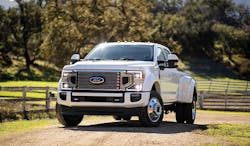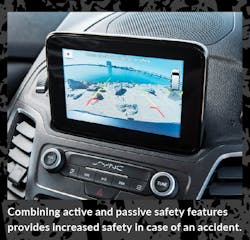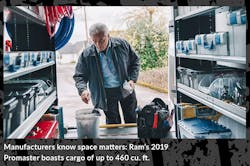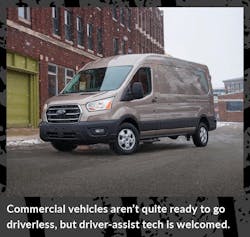Whether you run a one-man show or oversee multiple teams, your vehicles matter. Company owners today want advanced connectivity, sleek and efficient designs, and sustainable fuel sources. Manufacturers are aiming to deliver all of that and more.
1] Connectivity for all
It’s no longer an amenity, but a must. “Connected commercial vehicles are evolving not for entertainment reasons, but to keep employees safe and connected to the company,” says David Sowers, head of Ram Commercial Brand. “Customers are starting to demand it.”
Ford’s fleet marketing manager, Malene Lane, adds that the growing use of connected devices and vehicles in the fleet space is driven by the universal desire for more efficient workplaces. The data agrees with her: 48% of Americans say they don’t have enough time for the things they want to do, according to a Gallup poll. Increased efficiency has the potential to solve this.
As a result, says Lane, the demand for telematics—combining a GPS system with on-board diagnostics to record data on things like a vehicle’s speed, location, and typical fuel efficiency—is on the rise. “Customers have been using telematics for years for dispatching or to collect data on driver behavior,” she explains.A little too reminiscent of Big Brother? Maybe, but consider this: Providing company owners with data showing behavioral differences, like each driver’s typical fuel efficiency and time spent driving between locations, helps pinpoint areas for improvement and can facilitate constructive conversation about what needs to change.
Other popular connectivity features in the commercial vehicle space include radios that double as WiFi hotspots and infotainment systems that provide real-time traffic and weather conditions.
2] A Layout for every job
A vehicle often reflects the driver’s varying day-to-day activities: In my car, for instance, there’s always a yoga mat, a bottle of water,According to Lane and Sowers, commercial vehicles should do the same: One week, you’ve got a three-person crew repairing a roof; the next, you’ve got two installers replacing windows. Your vehicle needs to be able to handle any jobs coming your way.
With vehicles like Ford’s 2020 Transit Crew Van—which provides space for up to five people across two rows with side curtain airbags—companies can transport more employees than was previously safe (and legal) in vehicles with one row of seating, without sacrificing storage. And if you’re heading to a job where you don’t need the extra seats? Use that second row as extended storage. “These vehicles can be configured in a variety of ways, to accommodate different jobs,” says Lane.
Commercial trucks are seeing a similar trend: About half of GM’s 2018 pickup truck sales were crew-cabs (trucks with four full-sized doors and room for 4-5 adults), according to Rita Kass-Shamoun, assistant manager of dealer, fleet, and customer care for the company. “They’re a great option for customers who need a bit more passenger space,” says Kass-Shamoun.
This one comes to the U.S. from Europe. According to Sowers, European-style vans are taller and longer than previous styles popular in the States. They tend to be unibody in construction, too, unlike classic, body-on-frame American models (these often had the disadvantage of a front engine placed in a box in between driver and passenger seats, taking up potential storage space.)
“Traditional vans in the U.S. are capable, but they don’t leave a lot of weight left for customer use,” says Sowers. “The Euro-style van lowers the overall weight of the vehicle, giving users more freedom to store heavy equipment and materials without dinging the vehicle’s performance.”
One disadvantage of a taller van is instability, particularly in high winds and on tight turns—but the added weight from construction equipment and passengers counteracts it.
4] Keeping Assets safe
Every accident avoided saves companies anywhere from $10K-$70K, according to Sowers. If a vehicle is damaged or an employee is injured and can’t work, productivity takes a hit. So, it’s no wonder commercial customers are increasingly obsessed with safety.
Safety features commonly found in commercial vehicles today include front- and rear-collision warning, active emergency braking, blind spot monitoring, and adaptive cruise control.
5] Less Oil, Less Gas
The traditional recommendation for time between oil changes was 3,000 miles or three months, whichever came first. But today, many automakers suggest longer intervals. For example, Ram’s diesel engines are designed to handle an oil-change interval of 12,000-15,000 miles, according to Sowers (depending on factors such as driver behavior and the vehicle’s age).
This results in less time and money spent changing oil and more time with the vehicle in use. For the environmentalists out there, fewer oil changes is good for the planet, too: As it stands, nearly 500 million gallons of used motor oil move from rivers and streams into the oceans, according to a 2016 National Geographic article—making that oil the main source of petroleum pollution in marine environments.
Hybrid engines are a popular choice for those wanting to marry sustainability with power, with the U.S. Department of Energy Alternative Fuels Data Center reporting over 370K hybrid electric vehicles sold in the U.S. in 2017. “In the past, you needed a V8 engine,” says Sowers, “but now you can get a V6 hybrid engine that’s much more eco-friendly, and better for your wallet and time.”
Although it can’t propel the vehicle using solely electricity, a hybrid engine assists with start/stop capabilities and adds regenerative braking. When combined, these features increase vehicle efficiency by 20% over the useful life of the vehicle, according to Sowers. And, according to the U.S. Energy Information Administration, hybrid vehicles are 45% more fuel efficient than those that are gas-only.
About the Author

Kaitlin Schuler
Kaitlin Schuler is the special projects editor for Pro Remodeler.





